The next owner of this 1970 Chevelle SS 454 might face some tough decisions. It is a rock-solid classic that would undoubtedly benefit from a cosmetic refresh. However, it still wears its original paint, and the decision will be whether to follow that path or retain it as an original survivor. There is probably no right or wrong answer to that question, but it will be interesting to see whether one of our readers will be the person who ultimately makes that choice. Located in Hopewell, New Jersey, you will find the Chevelle listed for sale here on eBay. Some frantic bidding has pushed the price to $43,100, but it hasn’t reached the reserve.
When you sit back and consider its age, the Forest Green paint that the SS wears has survived pretty well. It isn’t perfect, but the shine is still impressive. There are some spots where surface corrosion may be emerging, which could tip the scales towards the buyer committing to a respray. It features white stripes, and these also show their age. Both the paint and stripes are at their worst on the trunk lid, so this area may have been exposed to harsh UV rays to prompt this level of deterioration. One problem that the buyer won’t be facing is rust. The photos don’t reveal any problems, and the owner says that the normally prone quarter panels and drop-offs are as solid as a rock. The Cowl Induction hood is in good condition, as are the Rally wheels. The trim and chrome present nicely, while the glass appears flawless.
This Chevelle rolled off the production line before emission laws could do their utmost to strangle the mighty V8. That means that this car’s numbers-matching 454ci big-block churns out 360hp. Rounding out the package are an M22 four-speed manual transmission, power steering, and power brakes. This SS is a genuine muscle car that is capable of blitzing the ¼ mile in 14.4 seconds. If the driver is brave enough to keep the right foot buried, the needle should eventually hover around 137mph. That’s pretty impressive in anyone’s language. We’ve reached a point in this classic’s story where we have to talk about a few upgrades performed by a previous owner. They swapped the original carburetor for a Holley Double-Pumpers and also thought that aftermarket headers would be a wise move. These changes have probably unleashed a few extra horses, but this has come at the cost of originality. However, all is not lost. The owner has managed to source a correct Rochester unit, which he has had rebuilt. It will be up to the buyer to fit this and locate a set of correct exhaust manifolds. With those items replaced, the engine bay will be back to its factory specifications.
The interior photos that the owner supplies are on the wrong side of ordinary, but this one shows one of the few faults inside this SS. The original bench seat has split on the driver’s side, and while repair may be an option, I suspect that the buyer will be spending $250 on a replacement cover. Otherwise, this interior doesn’t appear to need much. The remaining upholstered surfaces are in good order, as are the dash and carpet. A previous owner installed an aftermarket stereo, but thankfully, they didn’t cut the dash to achieve this. That leaves the way open for the buyer to install a factory radio to help retain this classic’s originality.
This 1970 Chevelle SS 454 is a car that should be capable of producing sub-15-second ¼-mile passes all day, and that was a large part of what these cars were all about when new. It is hard to believe that by 1973, the SS 454 would struggle to cover the same distance in under 16-seconds. The writing was on the wall for the mighty V8, and it would be more than a decade before the motor could recover the lost ground. That’s what makes cars like these so unique and why the bidding has been solid to this point. I’ve spent some time thinking about this car, and I can’t decide whether I’d restore it or leave it untouched. Which way would you jump if you found it parked in your driveway?





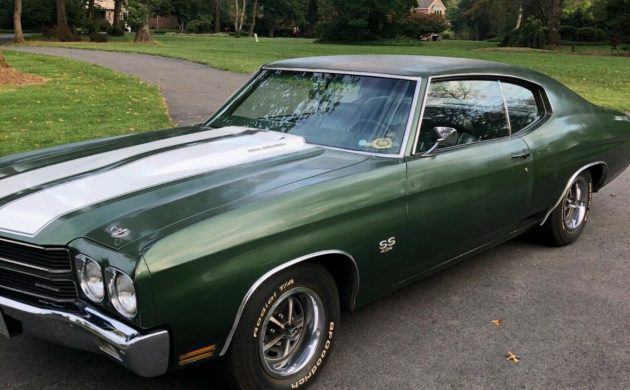
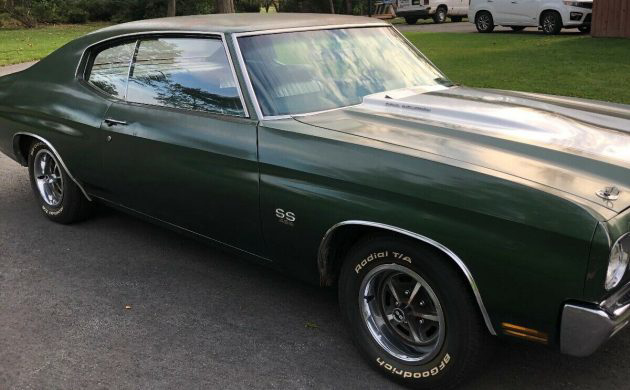
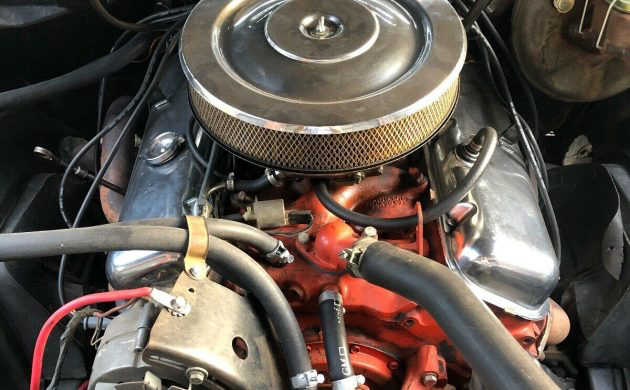
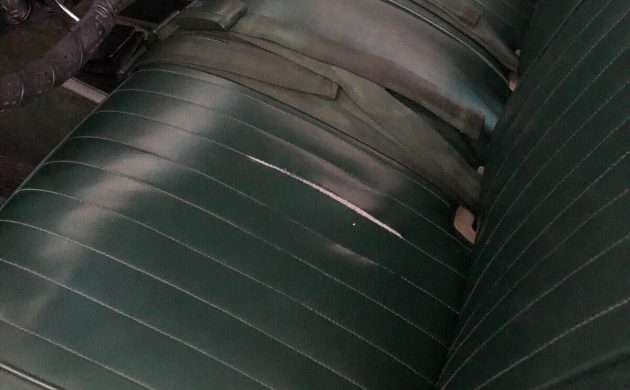
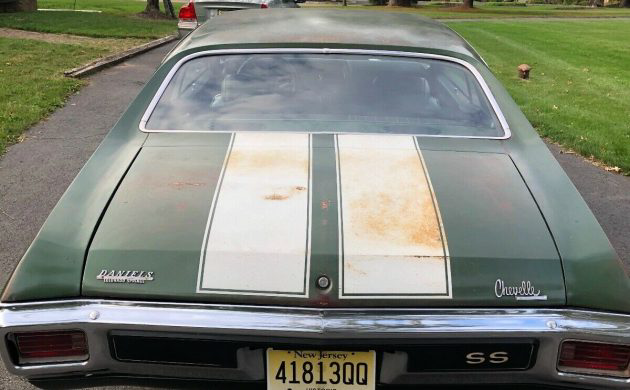
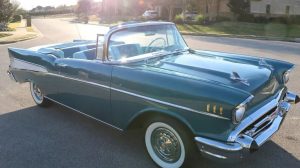
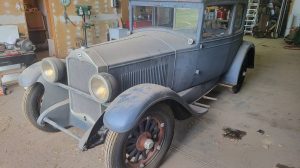
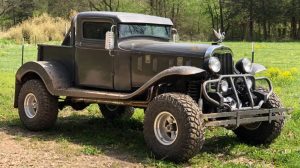



As Adam suggested, I would source a set of OEM exhaust manifolds, and drive/show it as-is. It has survived this long, keep it this way. It’s only original once, it will gather as much or more attention than a fully restored car at any show.
Leave the headers, double pumper Holley seems a bit much, leave that killer green paint job alone too, the interior should be left as original as possible, and enjoy a car from a time when there was no ” replacement for displacement “. With some fuel stations charging nearly five dollars a gallon drive this only a few miles a time,,,,,maybe only a quarter of a mile?
1970 was the peak…..for GM guys. Finally they could get massive cubic inches in the intermediates…oddly enough Ford had the smallest of the big three at 429 for that year in the Torino. So it wasn’t the pinnacle year for everyone.
now i hate to be that guy but if you go to the ebay add and look at the picture of the passenger side door panel, it clearly say Malibu and not SS, so that could mean a couple of different things, one of which being this car is not as original as it is said to be, or hey maybe that badge broke off and a Malibu badge go thrown on there, but what ever the case is that definitely is suspicious.
The Arlington plant was known for putting the Malibu emblem on the door panels of 454 cars.
Speaking of door panel emblems, the 1970 and up El Camino door panels never had a SS emblem either. You see them fairly often, they were added. They do look cool, but they are not original. Quadrajets were the most maligned carburetor design ever. Quadrajunk, Quadrabog, and other terms were applied because it was a new design, and guys were familiar with the Holley carburetor design. So at the first opportunity, they were replaced with a Holley dual feed and a matching aluminum intake. For those not wanting to swap intakes, the Holley Spreadbore was the answer. For street use on a basically stock engine, a double pumper also resulted in a huge bog, the result of dumping twice the fuel shot off idle. A cammed, low geared stick shift car or an automatic with a high stall was pretty much what you needed to run a double pumper. Pump shots were adjustable, but most of us didn’t really “tune” their Holleys other than changing jets. The majority of street cars ran best with a vacuum secondary set up with the correct spring. I remember the gear drive secondary kits they sold, they looked so cool and you got bragging rights, but for street use they were useless. Ask me how I know… There is also a huge misunderstanding to this day regarding “double pumpers” A Holley with a dual feed inlet line is not a double pumper. A true double pumper will have a 2nd accelerator pump on the passenger side for the secondaries. All that being said, I did all the stupid things with Holleys back then, but after many years, I have come to respect the Quadrajet, there are numerous guys that specialize in them. They can be made to perform well above expectations.
@piston pony , actually different assembly plans used a different emblems. It’s actually quite common to find an original 70 SS package Chevelle W/ Malibu door emblems.
The Daniels Chevrolet dealer tag on the trunk lid: Colorado Springs Colorado just a few miles from where I live. Another huge Plus if that car spent a number of years here…….
In a recent Hemmings Muscle Car magazine, referring to a green 69 Camaro that had sold for significantly less then estimate, the journalist wondered if it was because the green paint, like this Chevelle, was the cause because so many GM cars were painted this color. I like the color but think these beasts look best in Black, then red and silver.
Well, there’s an old saying, “Hey, I wouldn’t kick her out of bed!” To that I always said, hey, there’s more room on the floor, but I digress. This SS certainly deserves a good looking at by any serious buyer. Sure it has some warts and bumps and grit, and it reflects the stated mileage for sure. I would guess it hasn’t had an easy life!
For those that mentioned it, the Holley 6210 Spread-bore, double-pump carburetor was a great improvement over the stock Quadra-bog. It was almost impossible to not get a bog when the huge Q-jet’s secondaries dropped open and the 6210 solved that handily with the secondary pump. It was much easier to tune (re-jet) too and had jets on both primary and secondary metering plates. So, for originality, go with the Q-jet. For performance, stick with the Holley. Nice to see the owner has the proper air cleaner too.
Now the thing that bugs me most about this car, the Malibu door tag notwithstanding, is the stripes. They’re wrong. No radius on the outer corners and the narrow stripe is too wide. So either the car was ordered with the stripe-delete (which was possible) and someone added them after the fact, or the ‘original’ paint is not so original. I’d be searching for the build sheet.
This one’s going to take some work, but it’s definitely not one to kick out of bed! GLWS!
Not reading into the ad, my impression of “double pumper” Holley would be something like a strip dominator 850 or the hairy old three barrel Holley that flowed fuel like a volcano.
My clunker ’68 project Chevelle had a small 650 spreadbore Holley that had vacuum secondaries that wouldnt open until I trimmed the spring so it would open sooner and the 396 felt a little more lively. Its just me, when I hear double pumper Holley I’m thinking a well built track star.
The Arlington TX assembly plant built early 1970 SS hood stripes were applied with squared off corners. Apparently other plants also made a few, but generally speaking the majority of the later 1970 and on cars were rounded. Lots of forum discussions regarding the correct stripes out there. Early cars also included a bright aluminum trim that was located under the headlights extended behind the bumper. My 70 Elco SS has them, it was a early January built Van Nuys car. They were short lived, GM probably saved a few cents per dar deleting them. When I striped my Elco, I used the rounded style stripes, they just look better. Squared off stripes look like they were painted by the guys that did the Olds W-25 hood stripes. That hood is often called the W-30 hood by mistake, as they were standard on the W-30 and W-31 cars.
Not all stripes had radius’s in them. One G.M. plant made them squared off but correct otherwise. I believe that was on’70’s only.
Restored 1970 Chevelle SS-454s aren’t exactly common, but they’re generally available for a price. How often do you come across a numbers-matching 1970 SS-454 with original paint and interior, in fully drivable condition? With that context, there is definitely a correct answer to the “restore vs. preserve” question: this vehicle should be preserved in original condition.
Gee, we haven’t seen one of these Chevelle SS for quite some time. Just wondering, Jesse can you total up at the end of the year and give us a count on the most popular vehicle listed on BarnFinds?
I never had any trouble with the quadrajet bogging on my 1970 454 with the rockcrusher, but that doesn’t mean it was better than a Holley.. My LS5 idled smoothly at about 650-750 and had no bog. I think the quadrajet was supposed to be rated at 700-800 CFM which seemed to right for this engine..
I think I still have a set of those long high-flow secondary metering rods that came from Motion Performance in NY. They were very easy to install and you didn’t have to remove the top of the carb to put them in. I never had to use them on my 454 which didn’t seem to need them. There were a number of high performance items you could order for the quadrajet in the past like the high flow needle and seat.
It looks like a real SS but I have never seen the trunk stripes squared off on the outer edges.
Just puzzled as to why there is a red ground cable on the alternator bracket ??
Removed, 50,600, reserve not met.